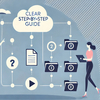![]()
Technical communication is the means to convey information that helps people interact with technology and solve complex problems. Any communication is mostly associated with texts, but tables, charts, drawings, photographs and other graphics are as important as written text. It means that technical communication is provided in the form of technical writing and technical illustration. But what technical illustration is about?
Understanding Technical Illustration
Technical illustration belongs to the broad field of technical communication, and defines technical information delivered through the means of visual aid. Its general aim is to effectively convey information via the visual channel to the target audience.
Technical illustrations generally describe and explain information to a non-technical audience. Therefore, visuals should be accurate in terms of proportions, and provide accurate impression of the described object.
In order to establish effective communication, text and visuals should be properly arranged on a page or computer screen, because pieces of technical communication require to be visually appealing, easy to understand and navigate.
Who is a Technical Illustrator?
Technical illustrators work with design teams and technical writers to create different technical graphics. These specialists produce images, diagrams and schematics to convey concepts and mechanical objects of various technical objects. Generally, these graphics are used to explain technical information for non-technical audience.

In order to get a position as a technical illustrator, one need to have an associate’s degree or courses taken in art, sciences, computer graphics and design or engineering. There are also training programs designed for technical illustrators, that teach computer graphics, visual design, technical terminology and computer-aided design (CAD).
Types of Communication via Technical Illustrations
According to the target audience, technical illustration can be broken down into three categories:
- Communication with non-experts allows to inform the general public. This type of illustrated instructions can be found in the manuals for automobiles and consumer electronics. It contains simple terminology and symbols that can be easily understood by the general public.
- Specialized communication is used by engineers or scientists to communicate with their peers and in specifications. This type of technical illustration uses complex terminology and specialized symbols. Examples can be found in the fields of atomic energy and aerospace.
- Communication between highly skilled professionals. In this case technical illustrations are used by engineers to communicate with non-engineers who are highly skilled in a field. Such examples are found in user documentation. These illustrations can be very complex and contain jargon and symbols not understood by the general public.


A Universe that obeys the laws of relativity and is filled, isotropically and homogeneously, with matter and/or radiation, cannot be static. It must expand or contract, dependent on what’s inside it and in what amounts. Image credit: E. Siegel / Beyond the Galaxy.
Source: https://clickhelp.com/clickhelp-technical-writing-blog/how-does-single-sign-on-work-guide/
Think About Your Readers
Technical communication, whether it is technical writing or technical illustration, all about effective delivery of information to the target audience. Therefore, in order to make your communications useful and persuasive, remember to constantly think about your readers.
It is obvious, for example, that instructional illustrations for LEGO are much simpler than those in user manuals describing how to set up an internet router. In case of LEGO, instructions heavily rely on the visuals as long as they are aimed at both children and adults, and require no bulky descriptions. Installation guide for an internet router is supposed for adult users with advanced knowledge in computing, therefore these illustrations may contain complex terminology and specialized symbols.
Tell Us More
Feel inspired to switch to technical illustration? Or maybe you already have some experience in the field? Please, share with us in the comments below.
Good Luck with your technical illustration!
ClickHelp Team
Author, host and deliver documentation across platforms and devices




